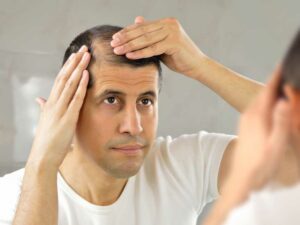Researchers say a compound used in laboratory experiments to block the production of estrogen also has the surprising side effect of awakening sleeping hair follicles. Their report in the October 29 issue of the Proceedings of the National Academy of Sciences says if the estrogen blocker proves safe for people; it could be used for hair loss caused by chemotherapy, male pattern baldness, or gradual thinning.
“It’s a novel finding, because a great deal of past research on hair loss has focused on androgens (male hormones), but not estrogens,” said study senior author Dr. Robert C. Smart, associate professor of molecular and cellular toxicology at North Carolina State University in Raleigh. Smart and his co-author, toxicology doctoral candidate Hye-Sun Oh, were not looking for a baldness cure when they made their discovery.
For three years their government-sponsored work had immersed them in the murky molecular waters of how a pesticide might biochemically interact with estrogen to cause cancer. But, they began to notice something strange happening. Hair stopped growing on the shaved skin of mice treated with a biologically active form of estrogen — 17-beta estradiol — even though the animals were at an age when hair growth should continue. And, when the researchers applied an estrogen blocker called ICI 182,780 just twice, tissue studies one week later showed hair follicles beginning to sprout hair.
“By two weeks, the visible hair growth on treated mice was about the same as on mice who had never been shaved, while mice that were not treated with the compound grew no hair,” Smart said.
The researchers soon switched the focus of their study to the links between estrogens, estrogen-receptor blockers, and hair growth. “Our findings indicate that an estrogen-receptor pathway in specific cells of the mice’s hair follicles somehow acts as a switch, essentially turning on and off hair growth,” Smart explained, adding that the study sheds new light on the role of estrogens in regulating the normal cycle of hair growth. “Hair follicles are complex, self-renewing structures composed of different types of cells,” Smart said, pointing out that specialized cells at the base of each hair follicle have long been known to regulate the shift between the growth and resting phases of the hair follicle cycle. “But no one was exactly sure how. We didn’t know what signals were given out by these cells to trigger other cell types into proliferating and forming active follicles. Essentially, it was a black box,” he said.
Smart’s research team now knows part of the answer: An estrogen receptor pathway is located in the nucleus of the dermal papilla cell at the base of the hair follicle. Whether estrogen-blocker treatments will work on humans remains unknown. The researchers are now trying to determine if the estrogen receptor in cells that regulate hair growth in mice is also present in people. “If it is there, it’s a good bet these treatments will have the same effect,” Smart said. With that in mind, the University’s office of technology transfer has applied to patent the use of estrogen blockers (such as that used in the study) for treating hair loss and promoting hair growth. According to Spencer Lemons, assistant director of technology transfer at North Carolina State University, the patent application aims to “protect” — for the patent holders — the use of estrogen blockers for hair loss, the same way a “new use patent” for the blood pressure drug minoxidil was obtained for its application to hair loss. “It’s a fairly common practice, especially in the pharmaceutical field,” he said.
Smart estimates it could take five years or more before testing is completed and the treatments become available commercially.





